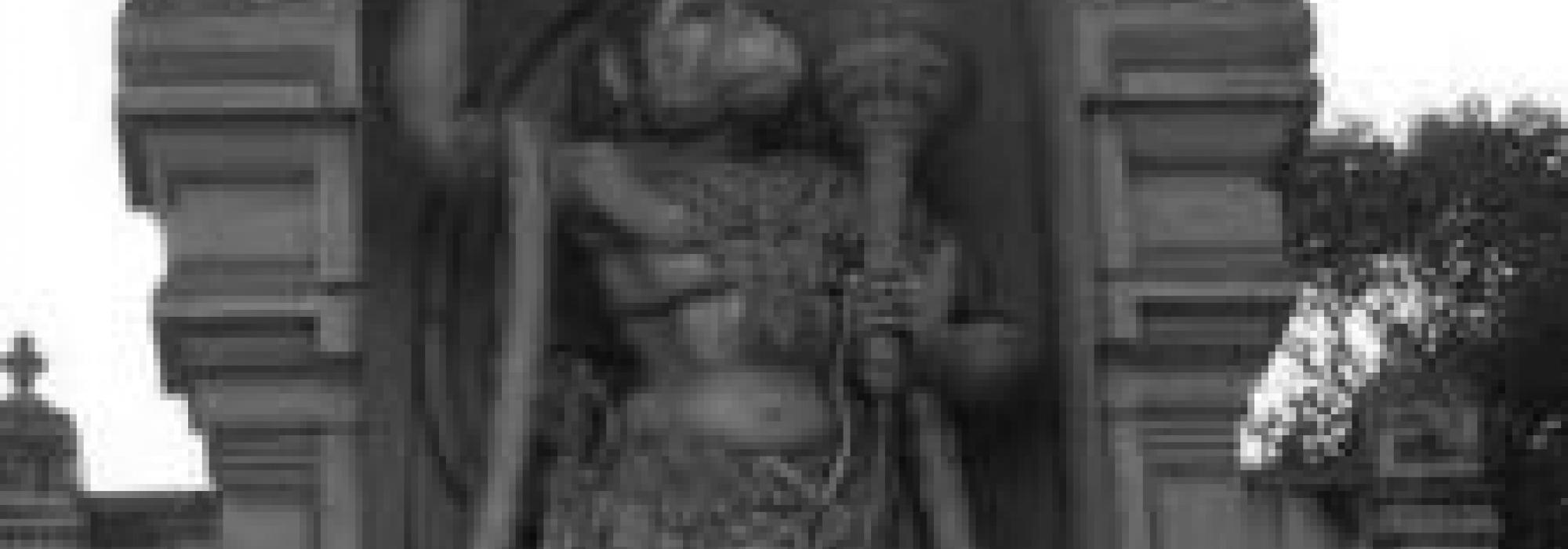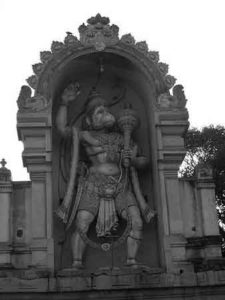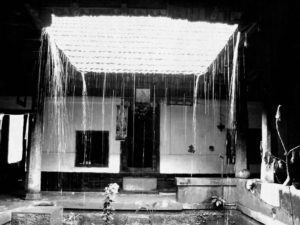The Anjaneyaswamy Temple of Mulabagal is extremely famous. Folks from the Mysore-Bangalore region who went on a pilgrimage to Tirupati would typically travel via Mulabagal, visit the Anjaneyaswamy Temple, take his Prasadam and resume their journey. According to one legend, this town derived its name “Mulabagal” because it lies to the east[i] of Tirupati. Apart from this main Temple, there were numerous other Anjaneyaswamy Shrines in the town. There were two in the Agraharam of the Madhva Brahmanas. My other university apart from my home was the Anjaneyaswamy Temple, located very close to my school. Whenever we had free time or made time, my friends and I used to spend most of our time in the ramparts of this Temple. My younger grandfather Sri Ramanna was one of the Trustees of the Anjaneyaswamy Temple. I’ve heard that he offered an armour named Vajranga (literally, “diamond armour”) to Anjaneyaswamy, and that he had left behind an endowment to perform various Pujas for two days in the Dhanurmasa (typically between mid-December and mid-January). He was a great devotee of this Deity. He would visit the Temple every evening for Darshan. If somebody fell sick in our home, the treatment we relied upon was this: a Prasadam comprising the flowers offered to Anjaneyaswamy, and the Angara given to devotees after worshipping him with incense. The courtyard of the Temple was really vast. Although the temple was named after Anjaneyaswamy, there were seven or eight temples of Vishnu within the complex of considerable size. The Temple faced westwards. Its main door was massive. Its dome was splendid and eye-catching. The front yard was spic and span at all times. It was a joy in itself to stand there and look around. When you turn left after entering the main door, you find a Pushkarini. Next to it was a small flower garden. When you walk forward from the Pushkarini and turn eastwards, you find a Ranganathaswamy Temple. The Murti of this Deity was taller than an average human. It was extremely beautiful. There was a Navaranga in front of the sanctum sanctorum and a Mukha Mantapa in front of it. There was a door to the southern portion of the Navaranga, which opened to reveal the Shrungara Mantapa. On the Mukkoti Dwadashi[ii], the Vaikunta Utsava was celebrated here too like it is celebrated at Srirangam near Tiruchinapalli. In the morning, the Utsava Murti (Procession Deity) would be taken out and Puja would be performed. Hundreds of devotees would assemble at the place in groups and take the Mangalarati and Prasadam. Opposite the Ranganathaswamy Temple was the Varadarajaswamy Temple. Walking alongside it, when you reached the rear portion of the Anjaneyaswamy Temple and circumambulated westward, you found an enormous and beautiful wedding hall. This was directly in line with the Pushkarini. When you walked further ahead from there, you came across the Venkataramana and Padmavati Temple. The Murti in this temple was also larger than life and very beautiful. The Navaranga and Mukhamantapa in this temple are expansive. After having a Darshan of this Deity, when you arrived at the central courtyard, the first thing that struck your eye was the large, half-moon shaped portico used for festivals. As if leaning against it was a huge Tulasi Shrine. Adjacent to this shrine were the Balipeeta, and flag post. In front of this was the Mukha Mantapa of the Anjaneyaswamy Temple. When you proceed from the left within this Mukha Mantapa, you first find the Alankara Mantapa. On festival days, the Murtis would be nicely decorated and placed in this Mantapa. Deeparadhana (lighting lamps), Mangalarati, and Mantrapushpam would then take place with great splendor. All the four walls would be colourfully painted with scenes from the Ramayana. This entire scene was not only visually appealing but was also inspirational. Next to the Alankara Mantapa was the temple of Sri Sanjivaraya—it was yet another Anjaneya Temple. When you turn southward from there, you found the temples of Kodandarama, Narasimhaswamy, Venugopalaswamy, etc. Adjacent to these was the Superintendent’s office. Facing it, you found bugles and a large silk-cotton tree. When you climb four or five steps from the aforementioned Mukha Mantapa, you enter the Anjaneyaswamy Mukha Mantapa. Beyond this is the sanctum sanctorum. And there he is in all his eye-arresting resplendence. The powerful Veeranjaneya Swamy. He stands there lifting his left arm high up in the air in a heroic pose of smashing a demon down on the ground. Manojavam Maarutatulyavegam Jitendriyam Buddhimataam Varissttham | Vaatatmajam Vaanarayuuthamukhyam Shriiraamaduutam shirasaa namaami|| To the south of the sanctum sanctorum was the kitchen. Close to the kitchen was a well. The water from this well was exclusively used for Anjaneyaswamy’s Abhishekam. Our sojourns were typically focused in this vicinity. We would obtain some Prasadam. The water had a divine taste. But most important of all was the opportunity for idle chatter, to climb trees, bite into raw fruit and throw it away, to get chided by the watchmen—this was our pastime.
Temple Staff
The staff of this large temple was equally large. The temple gardens held a similar attraction as did the temple and the dome. Wide roads on all four directions and small, clean roads in between. Little fences by the side of these roads. Gardens comprising numerous varieties of flowers inside the fences. All of these were visually appealing and brought cheer to the mind. This was the result of the vision and expertise of the Archakas of the temple. It didn’t happen because of a Government mandate. The Government simply carried on the tradition of the temple handed down from an ancient time. The Amaldar visited it once or twice annually, took the Darshan and left. His position was merely that of a supervisor. The everyday administration was in the hands of the Archakas. As far as I know, the chief among the Archakas was Sri Ramacharya. He had a matrimonial alliance with the Archakas of Tirupati. He would often visit Tirupati. Sri Ramacharya was one of my father’s close friends. Each time he returned from Tirupati, he would come home and give us a miniature of the Srinivasa’s Sacred Feet, Chandana, Vada and other items of Prasadam without fail.
Magnanimity of Feeling
The Archakas of the Anjaneyaswamy Temple belonged to the Vaikhanasa[iii] tradition. The fold of Srivaishnavism comprises two main traditions: the Paancharatra and the Vaikhanasa. I personally think that the Vaikhanasa is the more magnanimous of the two. Its adherents are not hypocrites. They are not imbued with hatred towards Shiva. One of the ancestors of Sri Ramacharya was Sri Gaurishastri. Perhaps his original name was Gaurishashastri (Gaurisha means “lord of Gauri or Parvati). This in itself is evidence of magnanimity. Shivasya hridayam vishnuh vishnosca hridayam Shivah|| In the heart of Shiva resides Vishnu and in Vishnu’s heart, Shiva || The Vaikhanasa Archakas of my town conducted themselves according to the preceding verse. They were all experts in the Agama Sastras[iv]. They were deeply learned in Sanskrit literature, they had mastered the Veda and they lived a spotless life.
Professional Competence
The Archakas of the Anjaneyaswamy Temple were not only experts in the Agama Sastra, they were also extremely competent in administrative tasks. Keeping the Mantapa environment of the temple at pristine cleanliness, enhancing the lushness of the garden, safeguarding the jewelry and precious clothing of the Deity, protecting the vessels and utensils, conducting Utsavas and other celebrations on schedule—they expertly executed these tasks. They had earned the trust, confidence, and respect of the entire town. They possessed genuine affection for the people. DevatAkshetra mAhAtmyam arcakasya tapObalAt || The glory of a place of pilgrimage lies in the strength of the Tapas of its Archakas. These Archakas were the living epitomes of this proverb.
My Puja of the Devatas
If I remember correctly, Sri Sanjeevappa was Sri Ramacharya’s father. He was equally renowned. I had been completely bowled over by the grandeur of the decorations during the Vaikunta Dwadashi festival. Accordingly, I wanted to install a Deity in my home and decorate it on a similar grand scale. And so I began to torment my younger grandfather to procure a Vigraha (or Murti, misleadingly referred to as “idol”). In this endeavor of performing my personal Puja, I had the encouragement of my grandmother and maternal uncle. Ultimately, Vidwan Sri Sanjeevappa got me a Vigraha of Sri Paravasudeva (or Krishna, the son of Vasudeva). It was extremely cute. To decorate it, I cut the edge of an ornately embroidered Kashmir shawl that my grandfather had given me and draped it around the Paravasudeva Vigraha. The moment my father learned of this, I ate a hearty feast of blows. But I’m obtuse. Sri Paravasudeva was frequently in my sighting until I had children of my own.
* * *
Another famous name among the Archakas was Sri Srinivasacharya or “Bandemane” Sheenappa. He was the father-in-law of Sri Ramacharya’s elder brother, Srinivasacharya. Sri Sheenappa was a prominent figure in our town. He had an expansive Tottimane—a traditional construction with wide courtyards and pillars with space for storing rainwater. He also owned land. His home was always filled with guests. His grandson is the recently-departed “Panditaratnam” Agama Vidwan Sri Venkataramanacharya. Two other famous Archakas were Sri Hanumappa and Sri Venkataramanacharya. They not only performed Puja and other services to Anjaneyaswamy but also did the same in the Kodandaramaswamy and Vittaleshwara Temples. Both were noble people.
Sri Krishnappa
It is absolutely important to recall the name of yet another Archaka, Sri Krishnappa. He was a learned Vidwan. His son, Sri Shyamadasa eventually went on to earn renown as a Harikatha exponent. Sri Shyamadasa learned Sanskrit and Telugu under the tutelage of Sri Venkatarama Shastri. Sri Venkatarama Shastri and the Archaka, Sri Krishnappa were close friends. Every afternoon at around three or four, both would sit next to each other on the stone bench in front of Sri Krishnappa’s home. Both of them had two boxes each made of nutmeg wood. One box contained marbles made of clay. They would pick up a marble, utter “Sri Ramaya Namah” and put it in the other, empty box. In this manner, which the first box became empty, it meant that they had uttered the name of Sri Rama one thousand times. As this Japa (chanting) was in progress, they would strike a cordial conversation with folks who passed by. “Hey Potter Gunagaa, are you fine?” “Washerman Subba, has your donkey’s leg healed?” “Limestone Mada, I heard you burned your hand?” These folks had faith in astrology and our Dharmashastras. Sri Krishnappa replied to each person with genuine affection and friendship. In this manner flowed the twin feelings in the lives of these Elders: of Bhakti towards Sri Rama and affection towards the world.
This is the English translation of the ninth chapter of D V Gundappa’s Jnapakachitrashaale – Vol. 5 titled “Vaidikadharma Sampradayastharu.”
Notes:
[i] The Kannada word for East is “Moodalu.” The word “Baagilu” means door. Hence, Moodala+Bagilu=Moodalabagilu. The corruption of this word gives us “Mulabagilu.”
[ii] This is also known as the Vaikunta Dwadashi celebrated in the Dhanurmasa every year in all Vishnu Kshetrams including Tirumala, Bhadrachalam etc.
[iii] The Vaikhanasa tradition is of untold antiquity is one of the principal traditions of Hinduism and primarily worships Vishnu and all his avataras, associated deities, etc. The tradition mainly follows the Taittiriya branch of the Krishna Yajur Veda and the Vaikhanasa Kalpasutra. Its name derives from the Sage, Vaikhanasa. Several prominent Vishnu-related temples in South India follow the Vaikhanasa tradition of worship. This includes the Sri Venkateshwara Temple at Tirumala, Sri Veeranjaneya Swamy Temple at Mulabagilu, Sri Chennakeshava swamy Temple at Tarakaturu, Machilipatnam, Sri Sundara Varadaraja Perumal Temple at Uthiramerur, Kanchipuram, etc
[iv] Loosely speaking, Agama Sastras comprise the entire body of knowledge governing temple traditions.
















































